Diseases of the musculoskeletal system in almost all cases are accompanied by dysfunction of its organs, which causes many difficulties to the patient.
An important symptom of musculoskeletal skeletal pathology is pain. Joint injuries are very unpleasant.
The hips are the largest of them all. Pain in the event of its defeat can be localized around it and give it to various anatomical structures: to the small pelvic organs, the lower back or the thighs.
General classification of causes
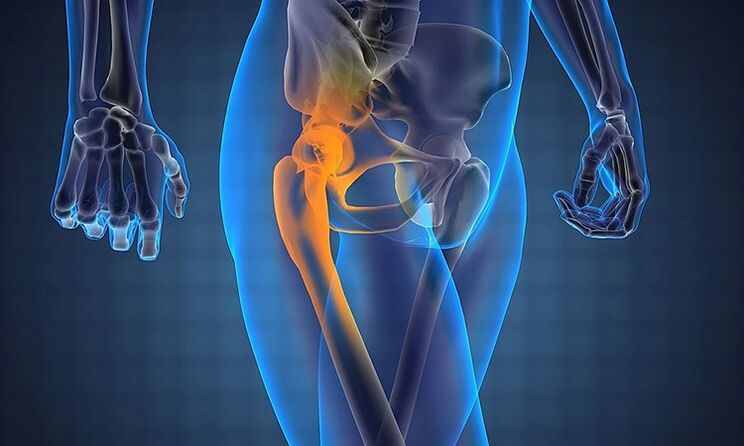
The etiology of hip pain varies.
In medicine, the following causes of arthralgia are conditionally distinguished:
- Inflammatory and infectious processes in the joints and surrounding tissues.
- Degenerative diseases of the musculoskeletal system.
- injuries.
- Bone and soft tissue neoplasms.
There are additional specific causes of arthralgia:
- Piriformis syndrome. Associated with his prolonged cramps.
- Femoral head necrosis (GBC). Often it is another pathological complication of TBS.
- Legg-Calve-Perthes disease. He is GBC osteochondropathy.
- Dissecting osteochondrosis. In different sources it may be called Koenig's disease.
- Diabetic osteoarthropathy. Complications of diabetes.
- Pseudogout. Also chondrocalcinosis.
- Intermittent hydrarthrosis is the excessive production of synovial fluid.
- Synovial chondromatosis (Lotsch syndrome).
Also, the feet in the hip joint area in pregnant women are often sore.
During this period, complex hormonal changes occur, the growing uterus replaces neighboring organs and tightens the ligament apparatus of the hip joint. In addition, weight gain increases the load on the legs. If dietary recommendations are not followed, pregnant women may suffer from calcium deficiency, because of this mineral imbalance, bone and joint structures are disrupted.
The cause of the pain
The prevalence of arthralgia increases with age.In children, symptoms of TBS (hip joint) disease occur with a frequency of no more than 10%, and in the elderly - from 50%. Most women experience this pathology. This is due to age -related hormonal changes after menopause.
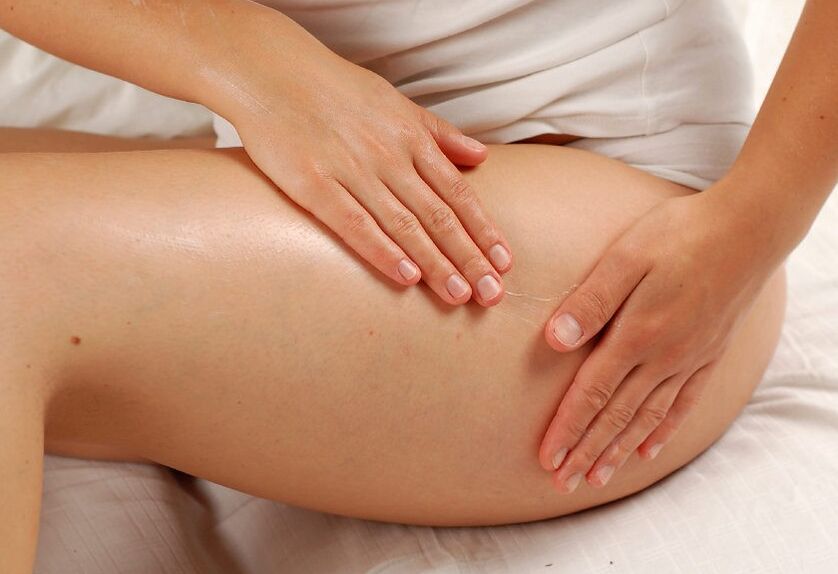
Why does the hip joint hurt? There is no definite answer to this question, as the list of reasons is quite long.
The main factors that cause arthralgia in the hip joint:
- Pathological processes in the muscle-ligament apparatus. Often, this is the result of direct mechanical action: bruising on the joint with subsequent inflammation of its components.
- Anatomical changes in the joints. They can be congenital or post -traumatic (dislocations, fractures).
- Pathology of other systems. Inflammation of the MT organ (small pelvis) can spread to the pelvic bones. Neurological disorders are indicated by pain of any localization. Metabolic disorders cause mineral imbalances. The bone-ligament connection is weakened, the risk of injury increases.
Inflammatory and infectious processes in the joints and surrounding tissues
The most common cause of arthralgia in any localization is suppuration of the musculoskeletal joints.
Inflammation of the hip joint is classified into:
- main. It is formed by direct penetration of pathogens into the joints: blows with sharp objects or blunt with the formation of wounds.
- Intermediate. TBS infection occurs from a distant focus of inflammation: through contact or through the hematogenous route.
Arthritis TBS
Often occurs in elderly patients.Painful pain in the hip joint, aggravated by walking, radiating to the groin, perineum and thighs. It is difficult for the patient to stand up from a chair or climb stairs without assistance. The discomfort is worse in the morning.
Therapy involves taking anti-inflammatory drugs and introducing glucocorticoids into the intraarticular bursa. If necessary, the cavity is dried.
Rheumatoid arthritis (RA)

This is a chronic systemic connective tissue disease similar to polyarthritis.The essence of this pathological process is inflammation of the synovium, cartilage and joint capsule. The reason is dysfunction of the immune system. Characterized by polyarthralgia, stiffness of movement in the morning, high fever are possible.
Affected shoulder and hip joints are very rare, pain only appears in the late stages of RA after several years from the onset of the disease.
Acute septic arthritis
This is a contagious childhood disease, 70% of cases occur in infants under 4 years of age. The causative agent is usually Staphylococcus aureus. The child refused to walk because of severe acute pain in the hip joint and in the groin when moving. Characterized by high fever and increased excitement.
Treatment involves removal of the effusion from the joint cavity and antibiotic therapy.
The risk of getting osteomyelitis and sepsis is high.
Tuberculosis or arthritis
Often, pediatricians face this disease. In young children, the immune system is underdeveloped, which leads to the possibility of infection.
The disease is characterized by slow progression. At first, the child quickly tired, his activity decreased, he stopped running. Gradually, atrophy of the thigh muscles occurs. Movement is obstructed. Pain in the hip joint in children acquires the character of intense pain, the limbs become longer than healthy ones.
If the pus dilutes the synovial membrane, then the exudate spreads along the muscles and tendons, forming phlegmon and fistulas.
If there are no complications, conservative treatment is carried out.
Tendovaginitis in the hip joint area
This pathology is inflammation of the muscle tendons and her vagina. Due to prolonged excessive use or injury to the legs.
The main complaints: sore femoral joint when moving, swollen lesions, changes in gait - lameness becomes noticeable.
Treatment-drugs: anti-inflammatory drugs, intra-articular injections of corticosteroids.
Bursitis
Of all the synovial bags, the acetabular exchange is most frequently inflamed.It partially covers the femur. With hip bursitis, the pain radiates to the thigh and gluteal areas. The patient is unable to lie on the affected side: the pressure in the synovial sac increases and the pain increases.
If there are no complications with bursitis, then the treatment consists of unloading the lower limb with a cane or cane.
Medications: Painkillers and corticosteroids.
Idiopathic ankylosing spondylitis

This is a chronic inflammation of the spine and elements of the sacroiliac joint.
The disease is dangerous because of its complications that reduce living standards and lead to disability.
If you find such a problem, you should immediately contact a specialist for the appointment of proper treatment.
The etiology is not entirely clear. Modern medicine suggests that the main cause is hereditary predisposition. Often people under 30 get sick.
Symptoms of idiopathic ankylosing spondylitis:
- Body temperature rises, fever.
- Drunkenness syndrome: general lethargy, weakness, poor appetite, weight loss, sleep disturbances.
- Persistent dull pain at the hip joint, as well as at the level of the sacrum and buttocks, spreads along the back of the thigh. Usually bilateral, at night their intensity increases.
- Limited mobility in the lower back and hips. These symptoms gradually spread to the upper part of the spine along the entire back, including the neck. As a result, the patient took the "petitioner pose" forcibly.
Rehabilitation therapy is based on special physiotherapy exercises for joint development.
Medications: NSAIDs to relieve pain and inflammation, corticosteroids.
Tendinitis
Athletes or people whose work is associated with heavy physical work are prone to tendon inflammation. Characteristic of the manifestation: aching pain in the hip joint occurs with a large load on it. During rest, discomfort is usually not observed.
It is recommended to reduce the load on the legs, in case of extension - a sleep break.
Drug treatment: NSAIDs, topical analgesic gels, glucocorticosteroids, chondroprotectors.
Syphilis
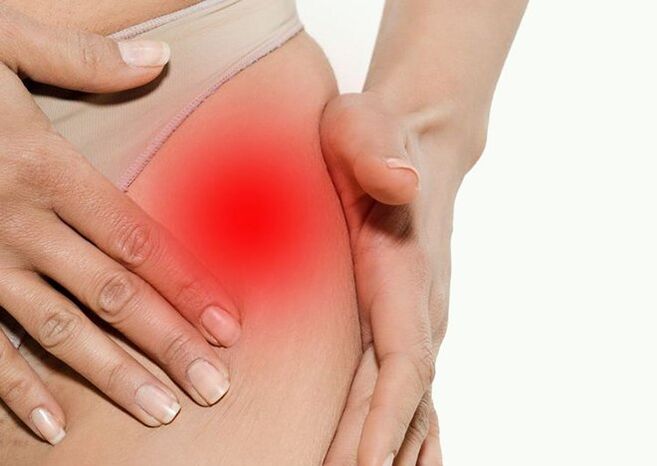
In the final stages of the disease, bones and joints are affected. Gum formation is characteristic. Their excessive pathological mineralization occurs. TBS is very rare.
Gumma - a node in the tissue, formed during advanced syphilis, destroying the surrounding tissue. This process ends with the formation of rough scars.
Treatment is ineffective, the risk of complications in the form of osteomyelitis is high.
Fungal arthritis of the hip
It occurs as a result of prolonged use of antibiotics and with pathology of the immune system.
People who are infected with HIV or have AIDS are particularly prone to fungal arthritis.
Pain in the joints is present continuously, having a painful character.
Fungal lesions on bone are characterized by a tendency to fistula formation, duration and difficulty of treatment.
Therapy: systemic antimycotics.
According to the instructions, surgical intervention was performed.
Bone and soft tissue tumors
Oncological disease of the hip joint can be a distant organ cancer metastasis or arise independently.
- Benign tumors of bone tissue - osteomas.
Foreign formations to the body grow, squeezing nerves and blood vessels. This clinic is similar to piriformis syndrome.
- Malignant bone tumors - osteosarcomas.
Neoplasms rapidly increase in size, necrotic and disintegrate, spreading metastases throughout the body.The pain in the hip joints at night is unbearable, they do not stop even after taking NSAIDs or trying anesthesia.
- Mesenchymal tumors are formed by soft tissue. The benign ones rarely recur and do not metastasize. Depending on the aggressiveness of the malignant cells, the intensity of the pain is variable.
Degenerative diseases of the joints
Coxarthrosis
Hip osteoarthritis is a chronic disease characterized by changes in the integrity of the articular surface, caused by violations of metabolic processes. It grows very slowly, over several years. Initially, cartilage tissue is affected, then bone tissue, followed by varus defects in joints and limbs. Occurs at the age of 40 years.
symptoms:
- The hip joint only hurts when walking.
- Stiffness of movement in TBS.
- During the process, a shortening of the limb length was observed.
- Weakness and atrophy of muscle mass.
- Lameness.
- When walking, a buzzing sound is heard.
- With bilateral lesions, a "duck gait" occurs - moving from one foot to the other.
Medications: NSAIDs, vasodilators, muscle relaxants, chondroprotectors, injection of hormone medications into the joint cavity.
Local effects: ointments, lotions, compresses.
In the last stages of the disease, surgery is being performed.
Osteochondrosis
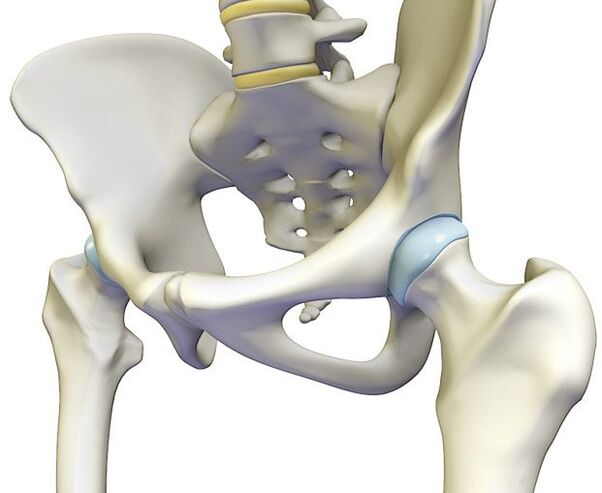
Degenerative changes in the intervertebral disc cause damage to the surrounding tissues.
symptoms:
- Pain in the lower back spreads to the hip and thigh joints.
- It was sudden, sharp and sharp. It starts in the lumbar and buttocks, down to the back of the legs.
- Unilateral localization of pain is more common.
- The patient assumes a forced position - lying on the healthy side.
- Probably a decrease in foot skin sensitivity.
Treatment is complex. Anti-inflammatory and analgesic drugs, moderate physical activity (swimming), physiotherapy after the subsidence of the most acute phenomena.
With significant pain, it is recommended to make an anesthetic blockade.
injuries
injuries
Pain of moderate intensity is characteristic, during active movement its intensity increases. The first time after an injury to the hip joint, a lameness appeared, which quickly passed.
During rest, symptoms disappear.
To relieve pain quickly in the event of an injury of the pelvic joint, it is necessary to apply a cold to the site of injury: ice packs or frozen products.
hip dislocation
Probably:
- Congenital. It is the result of an unsuccessful birth or intrauterine developmental pathology. The child had uneven gluteal folds and short limbs, possibly pinched nerves, indicated by seizures. If the dislocation is not corrected in infancy, then the child may become disabled.
- Traumatic. Symptoms: sharp severe pain, complete closure of joint function, massive edema and extensive hematomas appear over the damaged area. Getting up from a chair or bed becomes impossible for the patient without assistance.
If the hip is dislocated, you should immediately go to the emergency room or hospital.
broken bones
The hip joint is formed by strong, strong bones.
The most common diagnosis from this subgroup is a surgical femoral neck fracture. It is placed mainly on women after 60 years.
The cause of the damage is a fall or impact in the TBS area.
The strongest pain is felt, the hip joint pulls and abscesses, movement in it is almost impossible. The upper thigh area is swollen, extensive hematomas appear. The injured leg is shortened, the patient is lame. When moving, a special clicking sound is heard.
When a fracture occurs, the surrounding tissue is damaged, which is accompanied by a burning sensation. In the absence of treatment, the inflammatory process can begin here. If the nerves are pinched, you may experience numbness in the thighs.
Treatment is complex: surgical and medical.
Specific causes of arthralgia
Piriformis syndrome
With the localization of the pathological process in the hip joint area, the surrounding tissue is also affected. The long -term spasmodic piriformis muscle compresses the sciatic nerve and its ducts, causing several symptoms:
- Pain in the legs in the hip joint area. He went to the back and lumbosacral joints.
- Increased discomfort when leaning on the affected leg.
- Piriformis muscle compaction.
- Sudden "lumbago" pain along the nerve.
Etiology: injuries and infectious diseases and inflammation of the pelvic organs, vertebrogenic pathology, excessive muscle training, long -term maintenance of non -physiological posture.
Medications: NSAIDs, muscle relaxants, analgesics, circulatory repair, glucocorticoids.
After the decline of acute phenomena, remedial measures can be prescribed: physiotherapy, massage, acupuncture.
Aseptic necrosis of the femoral head
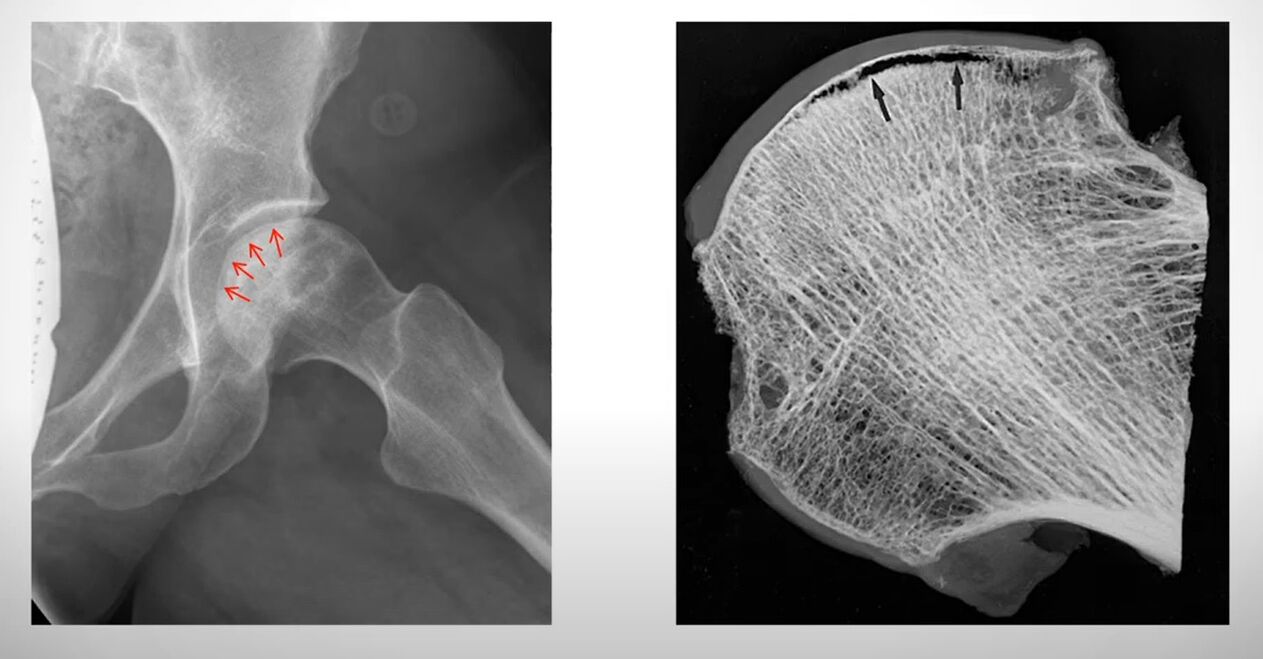
It mostly happens to young men. The etiology of this disease is upper thigh ischemia. With insufficient blood supply to the tissues, their oxygen starvation occurs and necrosis (necrosis) begins.
Clinical picture: sore hip joints and give to the legs and perineum. Reliance on an injured leg is unlikely. After a few days, the nerve endings melt and the pain disappears. This is a terrible sign! With necrosis of the deeper layers of the bone, the risk of rapid development of osteomyelitis and sepsis is high.
Treatment is surgery and drug therapy.
Koenig's disease
Dissecting osteochondritis - the exfoliation of a small area of necrotic cartilage from the bone and its protrusion into the articular cavity.
This is a rare disease. Common for men aged 15-35 years.
The patient complained of mild pain in the hip joint. Joints "stick" when moving.
Treatment is conservative (duration 10-18 months) and surgical. During the surgical intervention, the exfoliated mass is removed, the congruence (comparative) of the articular surface is restored.
Diabetic osteoarthropathy
Violation of glucose metabolism leads to disruption of blood circulation and preservation of all organs. Changes in the hip joint are more frequent one -sided: on the right, they occur more often than on the left. The immune response is reduced, which makes it easier for the body to become infected.
Clinical picture:
- Swollen joints.
- The skin on it is cold to the touch.
No pain syndrome in diabetic osteoarthropathy!
Treatment consists of careful monitoring of blood glucose levels and timely administration of insulin.
pseudogout
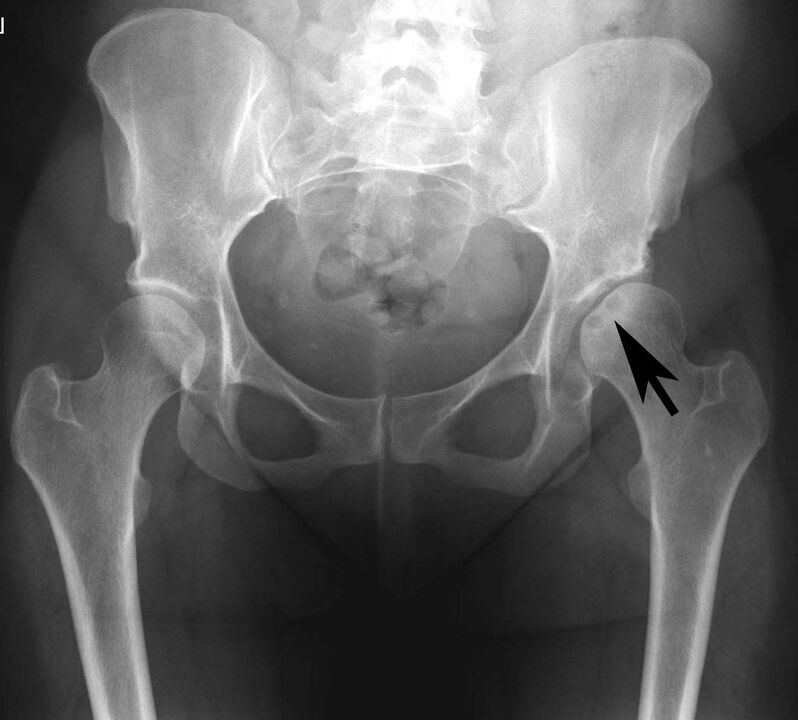
This pathology is the deposition of calcium salts in the articular cartilage.
Doctors associate it with endocrine pathologies: hyperparathyroidism, diabetes, gout, etc.
symptoms:
- It starts with acute pain in the hip joint.
Several types of calcium salts are known. With some of them (pyrophosphate), there is no pain.
- Movement in it is limited, abduction of the leg to the side is difficult.
- Edema and hyperemia are characteristic.
- Increased body temperature and fever.
To date, there is no specific treatment. Acute attacks are stopped with intra-articular administration of corticosteroids and NSAIDs.
Intermittent hydrarthrosis
This is a chronic disease, which is indicated by increased production of synovial fluid. prone to frequent relapses.
It is diagnosed mainly in women aged 20-40 years.
The etiology is unknown. There are two theories of the occurrence of this disease: it is associated with injury and is caused by endocrine disorders.
The size of the joint increases, becoming stiff.
The attack goes away on its own in 3-5 days.
Medical treatment is ineffective. Relapses occur even after surgery.
Synovial chondromatosis
This benign metaplastic disease is the replacement of synovial collagen with cartilage. The structure of the articular surface changes, as does its nature.
The chances of getting chondromatosis are higher in men, mostly in middle age and older.
The etiology is unclear.
There is local swelling, limited function of the joints, cracking during his work, arthralgia.
Treatment is only surgery.
Hip pain in children and adolescents
epiphiseolysis
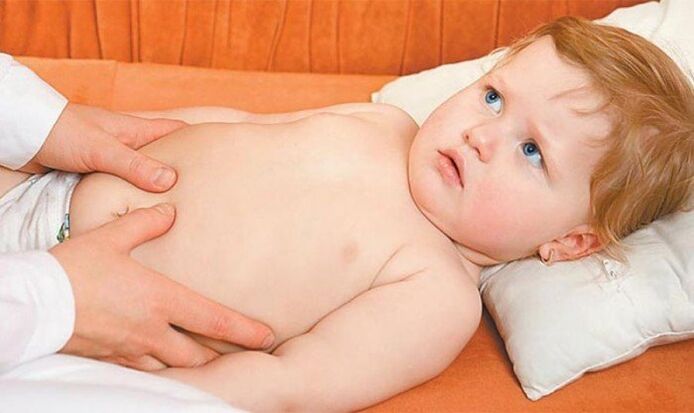
This pathology is most typical for children during puberty (from 11 to 16 years). Currently, there is a sharp spike in growth. Due to the weak growth zone, HBA slips into the neck, resulting in discomfort in the hip joint.
Children feel pain in the thighs, past the groin and knees. Lameness is observed, but dependence on the limb is maintained.
This disorder is corrected through surgery. You should start therapy as early as possible. Otherwise, HBA slippage can lead to the development of arthrosis and joint inflammation.
Dysplasia
It is the formation of excess connective tissue that can replace bone elements. As a result, solid anatomical structures become plastic, flexible. The ligaments, meniscus and tendons become weak. An unstable hip is formed, which is distinguished by frequent dislocations.
Dysplasia is a hereditary disease that usually occurs in infants from 3 months to 1 year. An orthopedic specialist can easily overcome the correction of foot settings.
Latent forms may appear in adolescence.
If you notice manifestations of club feet or foot deformities in children, then you should immediately go to the hospital for examination of the musculoskeletal system of the baby!
Dysplasia is then detected, the more problematic its treatment.
Osteochondropathy
This group of diseases includes bone lesions and cartilage tissue, in which the most overgrown areas experience aseptic necrosis.
Etiology: genetic predisposition, hormonal imbalances and infections can trigger this pathology.
In 30% of cases, the hip joint is affected. These are most common childhood diseases that occur in adolescents during growth spikes.
An adult should at an early stage determine the localization and nature of pain, contact a pediatrician and obtain the necessary information to prevent the development of complications.
Legg-Calve-Perthes disease
The syndrome is characterized by HBK necrosis in children under 15 years of age. The right hip joint is more often affected.
The cause of the pathological condition is a violation of blood circulation in the upper leg with the addition of cartilage tissue to the process.
Clinical picture:
- At first, the head of the femur hurts. With the development of necrosis, arthralgia suddenly disappears. This indicates the death of receptors of sensitive organs.
- Changes in gait - children begin to drown.
- Movement in TBS is limited.
- Often unilateral.
Complications: dislocation, coxarthrosis, deformity of the lower limbs, muscle atrophy.
Diagnostic measures
Before prescribing treatment, the doctor must carefully review the complaint, anamnesis and conduct an examination.
In the case of hip joint disease, the following studies are required:
- Laboratory blood tests (with inflammation, ESR increases and leukocytosis is observed).
- Normal radiography of a joint in two or more projections.
- MRI with or without contrast.
- MSCT. It is used to check for the presence of sarcomas.
- Osteoscintigraphy. radionuclide method. The most common and informative type of bone tissue examination.
- Ultrasound of the hip joint.
- Densitometers. Needed to determine bone density and strength.
If the patient cannot sit or stand, and it is not useful to relieve pain, then he is immediately sent to the hospital for further surgical treatment.
When to see a doctor immediately
- When there is a sharp pain when moving in the hip joint.
- If it is impossible to support the affected leg.
- Detection of lumbar and femoral edema.
- Redness or bruising in the affected area.
There are folk ways to relieve pain in the pelvic joints. Relying on these tips for quick healing is not worth it. Without a thorough diagnosis, it is impossible to determine the cause of arthralgia, and the drugs themselves will lead to the development of complications.































